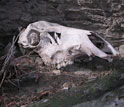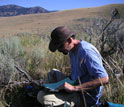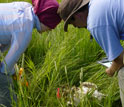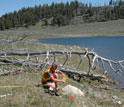News Release 11-061
Bones of Long-Dead Animals Conjure Ghosts at Yellowstone
Skeletons strewn across landscapes tell story of how animal populations have changed
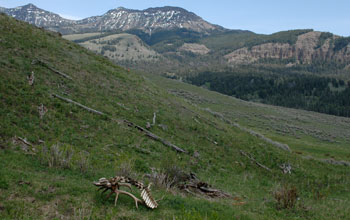
Partial elk carcass along the Northern Range in Yellowstone National Park.
March 28, 2011
This material is available primarily for archival purposes. Telephone numbers or other contact information may be out of date; please see current contact information at media contacts.
They tell a story, these bleached bones that gleam in the sun in Yellowstone National Park.
Bones on landscapes like Yellowstone may provide detailed accounts of how animal populations have changed over the last few decades or even century, scientists have found.
"The skeletons of long-dead animals lying on landscapes provide critical insights into our understanding of ecosystem history, especially how populations have changed," says biologist Joshua Miller of Wright State University in Dayton, Ohio.
His results, published today in the journal PLoS ONE, provide a deeper context for the many disturbances altering ecosystems around the world, including global warming, overharvesting and habitat destruction.
Miller performed much of the research while doing his Ph.D. work at the University of Chicago.
"These changes result in population reductions and extinctions of some species, while others expand and invade new habitats and regions," Miller says.
"Most ecosystems have not been studied over long time spans--many decades at least--which hampers the ability of wildlife managers and other scientists to properly document or mediate these dramatic ecological changes."
In his research, Miller surveyed bones from the skeletons of hoofed mammals, or ungulates, in Yellowstone National Park.
Then he compared the numbers of each species documented in bones, to surveys of the living populations.
He found that all native species in the living community were recovered, and that the order of species from most abundant to least abundant was similar for the bones and for the living community.
"While the fossil record yields valuable insights into ancient ecological communities, understanding community change over the time scale of centuries has been difficult," says Saran Twombly, program director in the National Science Foundation's (NSF) Division of Environmental Biology, which funded the research.
"Here, clever use of vertebrate death assemblages in Yellowstone provides clear evidence of species shifts over the past century or more.
"This technique extends our ability to document long-term changes in ecological communities--an ability of growing importance as global change, habitat destruction and anthropogenic disturbance alter ecosystems at increasing rates."
The bones of Yellowstone correlate well with the area's historical ecosystem, and provide more detailed information about the historical community than can be acquired from just studying the ecosystem today.
Species whose populations significantly diminished or expanded over the last 20 to 80 years were over- or under-represented in the bones relative to the living community.
"Elk, for example, were much more abundant in the 1990s than they are today," Miller says. "The bones of Yellowstone feature far more elk than one would predict based on the current Yellowstone community."
Horses, which were replaced by cars as the dominant mode of transportation in Yellowstone in the early 1900s, also were readily found as skeletal remains.
Radiocarbon dating confirmed that horse bones were remnants from when the cavalry controlled Yellowstone in the late 1800s to early 1900s.
In contrast to these ghosts of larger past populations, species that have recently increased in abundance--bison and the newly arrived mountain goat--are less common in the skeletal record than current living populations would predict.
"Bones provide a great tool for uncovering historical ecological data, which allows us to put modern biodiversity in a broader temporal context," he says.
"The living populations of Yellowstone have been studied for a long time, and provide a great opportunity to test how well bones record their histories.
"Now we can go the next step and use bone accumulations in regions we have only recently begun studying to obtain critical historical data, and establish how ecosystems have changed over the last decades, century or even longer."
Miller's research also suggests that the information contained in the fossil record may provide more details on extinct ecosystems than previously thought.
For those who would listen, dead animals have important tales to relate.
-NSF-
-
Miller and colleagues found many elk carcasses during their Yellowstone field research.
Credit and Larger Version -
Biologist Josh Miller studies bone survey data sheets along Yellowstone's Northern Range.
Credit and Larger Version -
Cara Harwood and Josh Miller investigate an elk skull in Yellowstone.
Credit and Larger Version -
Researcher Jared Singer maps a carcass in Yellowstone National Park; flags mark bone locations.
Credit and Larger Version
Media Contacts
Cheryl Dybas, NSF, (703) 292-7734, email: cdybas@nsf.gov
Steve Koppes, University of Chicago, (773) 702-8366, email: skoppes@uchicago.edu
The U.S. National Science Foundation propels the nation forward by advancing fundamental research in all fields of science and engineering. NSF supports research and people by providing facilities, instruments and funding to support their ingenuity and sustain the U.S. as a global leader in research and innovation. With a fiscal year 2023 budget of $9.5 billion, NSF funds reach all 50 states through grants to nearly 2,000 colleges, universities and institutions. Each year, NSF receives more than 40,000 competitive proposals and makes about 11,000 new awards. Those awards include support for cooperative research with industry, Arctic and Antarctic research and operations, and U.S. participation in international scientific efforts.
Connect with us online
NSF website: nsf.gov
NSF News: nsf.gov/news
For News Media: nsf.gov/news/newsroom
Statistics: nsf.gov/statistics/
Awards database: nsf.gov/awardsearch/
Follow us on social
Twitter: twitter.com/NSF
Facebook: facebook.com/US.NSF
Instagram: instagram.com/nsfgov

